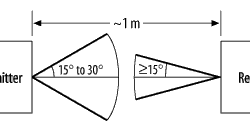IrDA interface for an embedded systems

IrDA is a transmission standard commonly used in computers and peripherals like mobile phones. The primary purpose of IrDA is to provide device-to-device communication over short distances. IrDA solves the problem of usage cables, which may differ from machine to machine. With IrDA, no wires are required, so this is easy to connect the same device to multiple device types like your mobile phone to laptops, other mobile phones, or PDA’s. IrDa standard requires close communication of devices. This is low power transmission. It is essential because regulations are guarding the maximum level of IR radiation that can be emitted. It is also reasonable to assume that the two devices to communicate will be physically pointed toward each other before use. And only two devices can communicate at the same time. So IrDA doesn’t have to deal with collisions. And the main thing that IrDa is simple, cheap, and requires low-cost parts. The IrDA standard specification states that supported data rates can be between 2400bps and 115.2kbps over 1-meter distances. Later standard has expanded to support 1.152 and 4 Mbps. The transmitter beam angle is from 15 to 30 degrees, and the receiver has A viewing angle of 15 degrees.…

